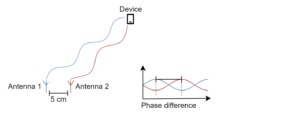Angle-Of-Arrival – An internal project
Keeping track of all the Bluetooth devices that exist today may not seem like an easy task. We use headsets, mobile phones, keyboards and office equipment which all communicate with each other wirelessly. You probably have one or more devices connected at this very moment.
What if we could utilize these signals that are being sent, and locate where they are coming from? Could the direction of these signals be used to improve the usage of these devices?
Introduction – Angle-of-Arrival in use
It is possible to track and calculate the direction of these signals by using something called Angle-of-arrival (AoA). In essence, you would use multiple receivers located a certain distance from each other, in order to measure the offset of the signal for each antenna. Since a signal is a travelling wave, sampling at different locations will yield different results, as the signal has traveled different distances. This is what’s called the signal’s phase attribute, which makes us able to calculate the Angle-Of-Arrival. The figure below demonstrates this phenomenon, in which the blue signal (left) travels a longer path than the red signal (right), resulting in a phase difference between the two. We can use this phase difference and the known signal wavelength to estimate the direction of the transmitting device.

As an internal project
Building knowledge is essential for overall growth and increasing opportunities as a company. At EmLogic, we thrive to learn new things and develop cutting-edge technology, which means that internal projects within the company is just as important as any other task.
Through this project, we’ve challenged several new employees with various obstacles. Ranging from Bluetooth sampling on a realtime operating system (RTOS), to complex signal processing algorithms for angle estimation. We’ve built competencies around this technology within our company, both for junior and senior engineers. Learning is a crucial part of the process, but the process is also a part of learning.
Cooperation and communication
During research and development, there are always stepping stones. Some are bumpier than others, but they are always present. Good communication skills are essential for being effective and sharing knowledge, in order to reduce and mitigate the number of bumps. Understanding all parts of this technology would not be possible without the coordination between embedded software, digital signal
processing and hardware.
We’ve built knowledge; we’ve created software and we’ve learned algorithms. Ultimately, we’ve done this to better understand how we can utilize this technology in the future, especially towards future customer projects.
